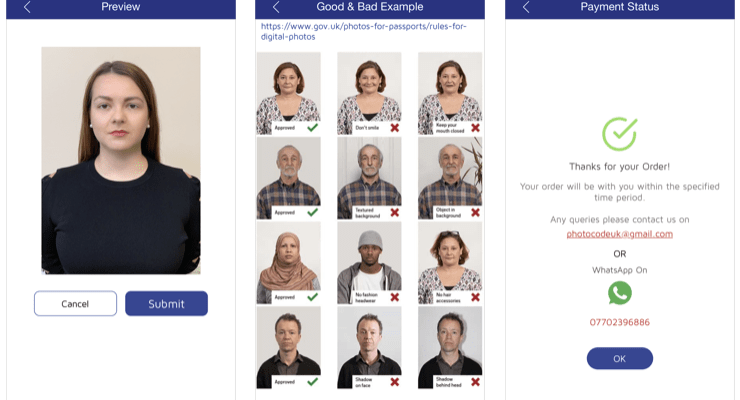A Passport Photo Vs. Photo for Visa: Unveiling the Distinctions: In an increasingly interconnected world, travel has become an integral part of our lives. When embarking on international journeys, individuals encounter various requirements, one of which is providing a photograph for official documents like passports and visas. While passport photos and visa photos share similarities, they also possess subtle yet crucial distinctions. This essay aims to elucidate the dissimilarities between a passport photo and a visa photo, shedding light on their unique requirements and purposes.
Passport Photo Vs. Photo for Visa
Purpose and Usage:

A passport photo serves as a visual representation of an individual that is affixed to their passport. It primarily serves the purpose of identification, facilitating travel across borders. Visa photos are specifically used for granting permission to enter a particular country for a specified period and purpose. Unlike passport photos, visa photos are not affixed to a document but are instead attached to the visa application form.
Specification Requirements:

Both passport photos and visa photos must comply with specific guidelines, ensuring consistency and accuracy across different documents. However, variations in requirements can arise, often due to disparities in regulations set by foreign countries. Travel maps comply with international standards set by the International Civil Aviation Organization (ICAO) for uniformity. This standard specifies specific information such as image size, angle size and resolution The ICAO guidelines require a neutral facial expression, with the eyes open and visible. The photo should have a plain and light-colored background to ensure clarity and contrast.
International Civil Aviation Organization (ICAO):-
Visa photo specifications may be more nuanced, with certain countries imposing additional guidelines unique to their visa application process. Some countries may have specific requirements for the size of the photo, background color, and even head covering.
For example, countries with conservative customs may require women to wear a headscarf in their visa photos. It is crucial for applicants to thoroughly research and adhere to the specific visa photo guidelines provided by the embassy or consulate of the destination country.
Background and Composition:

A key distinction between passport photos and visa photos lies in the background and composition. For passport photos, a plain and light-colored background is typically required to ensure clarity and contrast. This allows the facial features of the individual to stand out prominently and aids in accurate identification. The background should be free from shadows, patterns, or any distractions that may interfere with the photo’s clarity. In contrast, visa photos may have varying background color requirements depending on the country’s regulations. Some countries may allow plain backgrounds, while others may necessitate specific colors or even a completely white background. It is important for visa applicants to carefully follow the background guidelines provided by the respective embassy or consulate to avoid any delays or rejections in the visa application process.
Expression and Clothing:

Passport photos have strict guidelines regarding facial expression, with a neutral expression being the norm. The individual should face the camera directly, with eyes open and clearly visible. Smiling, frowning, or exaggerated facial expressions are usually prohibited to maintain consistency in identification. The purpose of a neutral expression is to ensure that the individual’s facial features are easily recognizable and consistent across different identification documents.
Conversely, visa photo requirements might allow slight variations, permitting a natural smile or other expressions, as long as they do not compromise the applicant’s identification. Some countries may even explicitly state whether a smile is allowed or not. It is important to carefully review the visa photo guidelines provided by the destination country to understand their specific requirements regarding facial expressions.
Regarding clothing, passport photos generally require plain attire. Bright or patterned clothing that distracts from the face is typically discouraged. However, visa photos may allow more flexibility, taking into account the cultural practices or customs of the destination country. For example, some countries may require individuals to wear traditional clothing or adhere to specific dress codes for visa photos. It is crucial to consult the embassy or consulate guidelines to ensure compliance with their clothing requirements.
Updates and Renewals:

Passport photos are typically valid for the duration of the passport’s validity, which is generally ten years for adults. Therefore, individuals need to renew their passports and submit a new photo when it expires. The photo must reflect the current appearance of the individual to ensure accurate identification. If there have been significant changes in the individual’s appearance, such as a drastic hairstyle change or facial modifications, it is advisable to update the passport photo.
This requirement ensures that the photo accurately represents the current appearance of the applicant at the time of the visa application.
Passport and Visa Photos are Both Required for International Travel
Passport Photo
- Size: 2 x 2 inches (51 x 51 mm)
- Background: Solid white
- Expression: Neutral
- Head covering: No head coverings are permitted, except for religious purposes.
- Glasses: Glasses are allowed, but you can not use any dark lenses.
Visa Photo
- Size: 35 x 45 mm
- Background: Solid white or off-white
- Expression: Neutral
- Head Cover: Head covering is not permitted except for religious purposes.
- Glasses: Glasses are allowed, but you can not use any dark lenses.
- Hair: Your hair should be neat and not in your face.
- Grooming: Makeup is allowed, but it should be natural.
Download Application
Android Application for free download
iPhone Application for free download
Although passport photos and visa photos share the fundamental purpose of identification for international travel, they possess subtle distinctions. These dissimilarities arise from differences in purpose, requirements, and usage. Understanding these disparities is essential for individuals planning to embark on international journeys, as it ensures compliance with regulations and streamlines the visa application and passport issuance processes. By adhering to the unique specifications for each type of photo, travelers can confidently navigate the bureaucratic landscape, facilitating smoother travel experiences.



